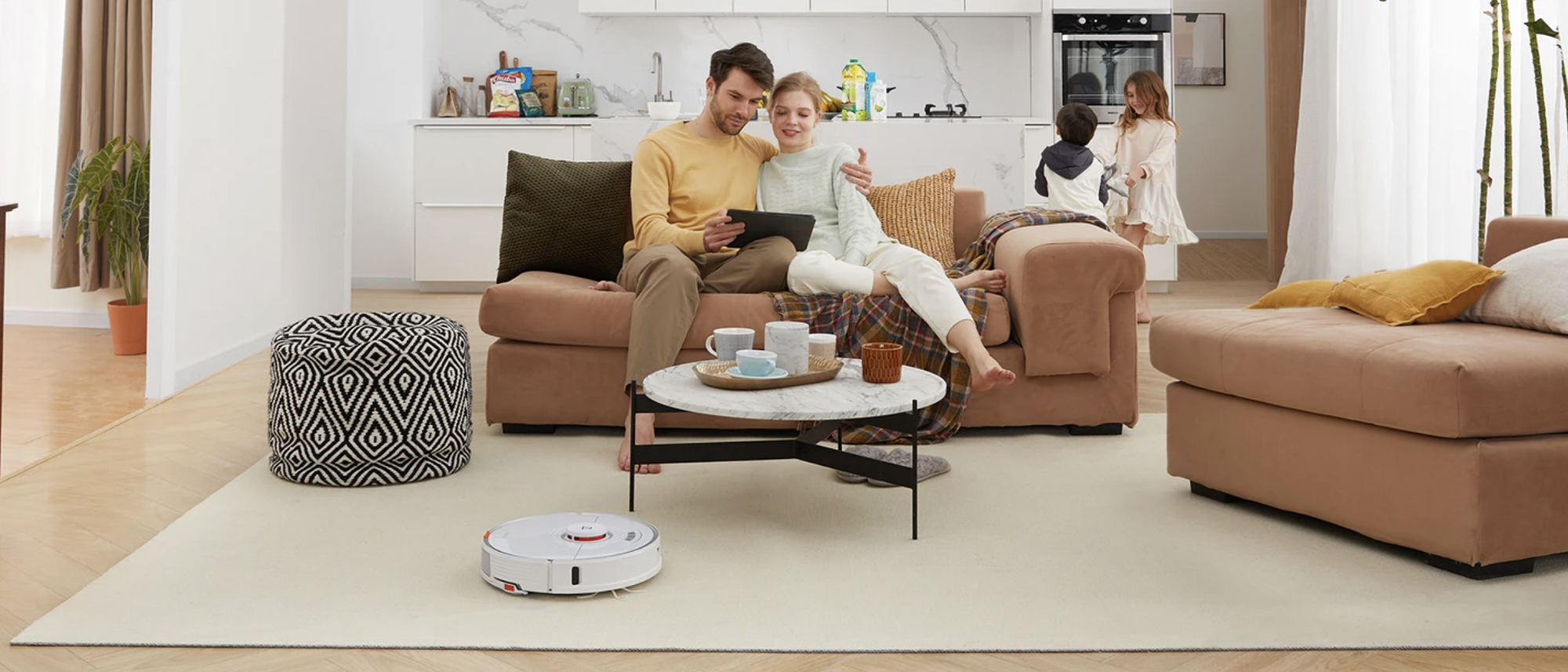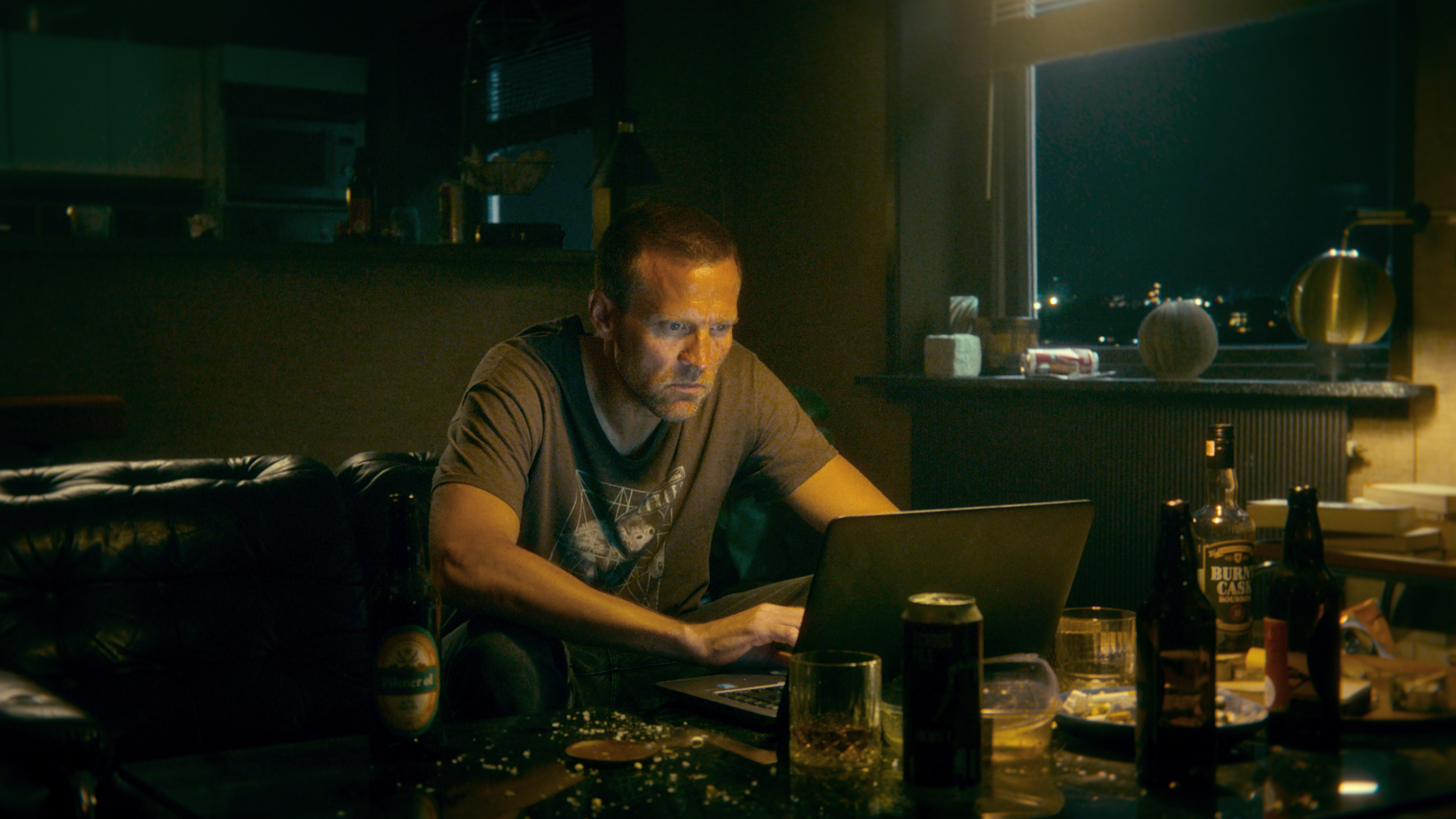Tom's Guide Verdict
The Roborock S7 is the first hybrid robot vacuum and mop we’d actually use.
Pros
- +
Accurate carpet detection
- +
Fast mapping
- +
Auto-raising mop works well
Cons
- -
Dividing spaces in app can be glitchy
- -
Mop pad can catch on area rugs
Why you can trust Tom's Guide
Price: $649.99 ($599.99 at Walmart)
Size: 13.9 x 13.8 x 3.8 inches
Modes: Vacuuming, mopping
Weight: 10.4 pounds
On board dustbin capacity: 0.47 liters
Smart home compatibility: Alexa, Google Assistant, Siri
Modern society is built around multitasking, so why expect anything less from our robot vacuums? The Roborock S7, the latest hybrid robot vacuum and mop from Roborock, does just that. Previously, we would never have allowed an unsupervised hybrid robot to run wild around our house with a full tank of water. But, the S7 is smart enough to raise its mop when it detects carpet, making it an intriguing solution to a long-standing hurdle.
In addition to mopping smarts, the S7 offers strong vacuuming performance paired with fast mapping and an app that’s full of customizations. While it’s not perfect, in our Roborock S7 review, we finally found a hybrid robot vacuum and mop we can trust.
- Best robot vacuums
- What you need to know: Robot vacuum buying guide
- Best robot mops
The Roborock S7 also earned a Highly Recommended nod for the Best robot vacuum award in the Tom's Guide Awards 2021 for smart home devices.
Roborock S7: Price and availability
The Roborock S7 was released on March 24, 2021, and is available at Amazon for $649 and Walmart.com for $599. It's currently available in white and black. There's also the option to buy a compatible Auto-Empty Dock either as a set or independently. On its own, the dock costs $299 from Amazon.
Roborock S7: Design
The Roborock S7 doesn’t break any new design ground. At a glance, it could be mistaken for the Roborock S6 MaxV, minus that model’s dual front cameras. Both vacuums are 13.9 inches by 13.8 inches around and stand 3.8 inches tall, fairly large as robot vacuums go. Neither could fit through the legs of my dining room chairs the way smaller bots, like the 13.3-inch Roomba i7+ can.
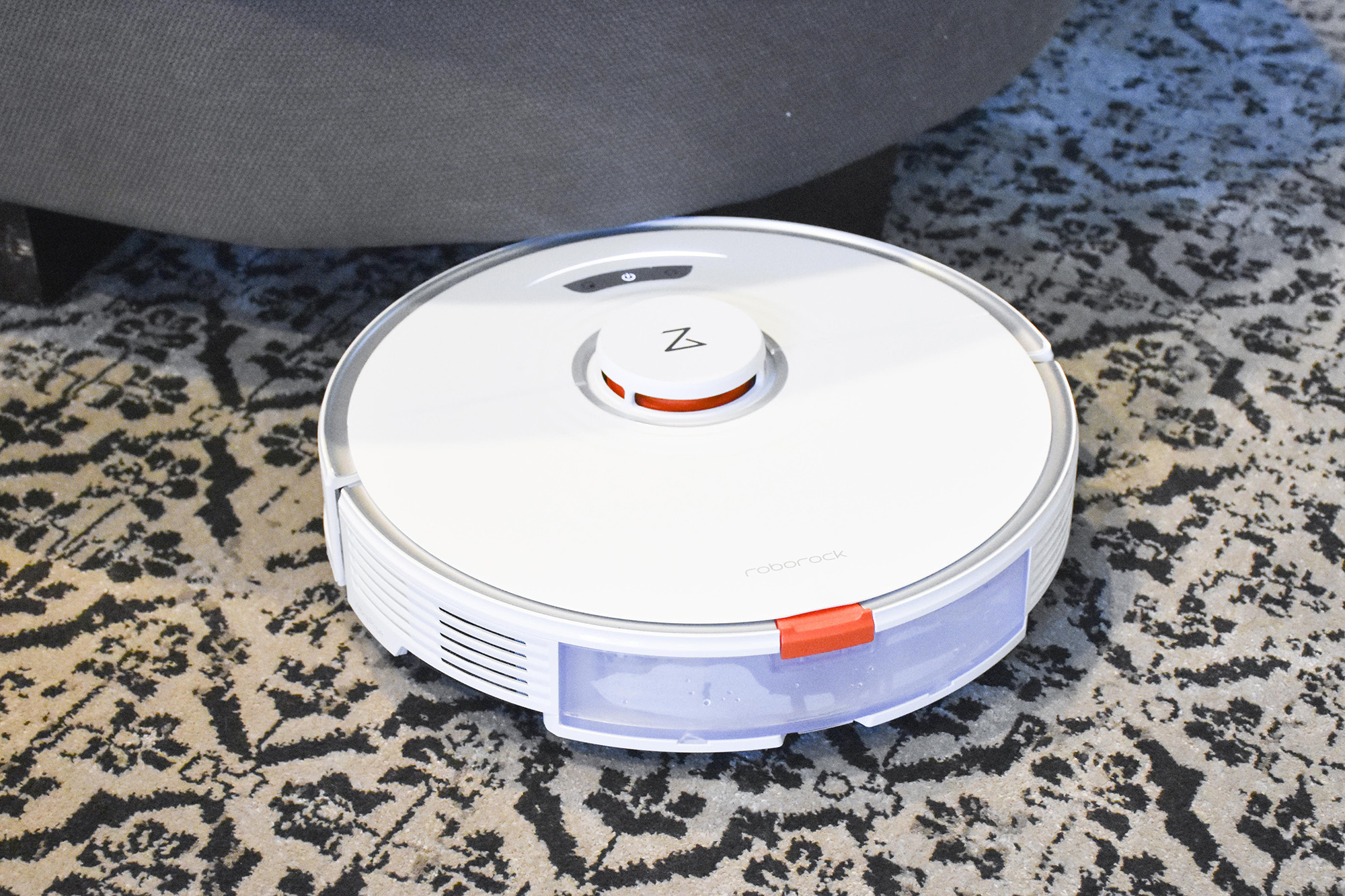
However, the S7 looks classier than both its sibling and the Roomba i7+. It’s clad in shiny white plastic with brushed silver trim around the top, A raised disc in the center features the Roborock logo and conceals the Lidar sensor. Silver buttons for spot cleaning, power/start cleaning, and docking are placed near the front. A bright orange button at the rear releases the onboard water tank.
Get instant access to breaking news, the hottest reviews, great deals and helpful tips.
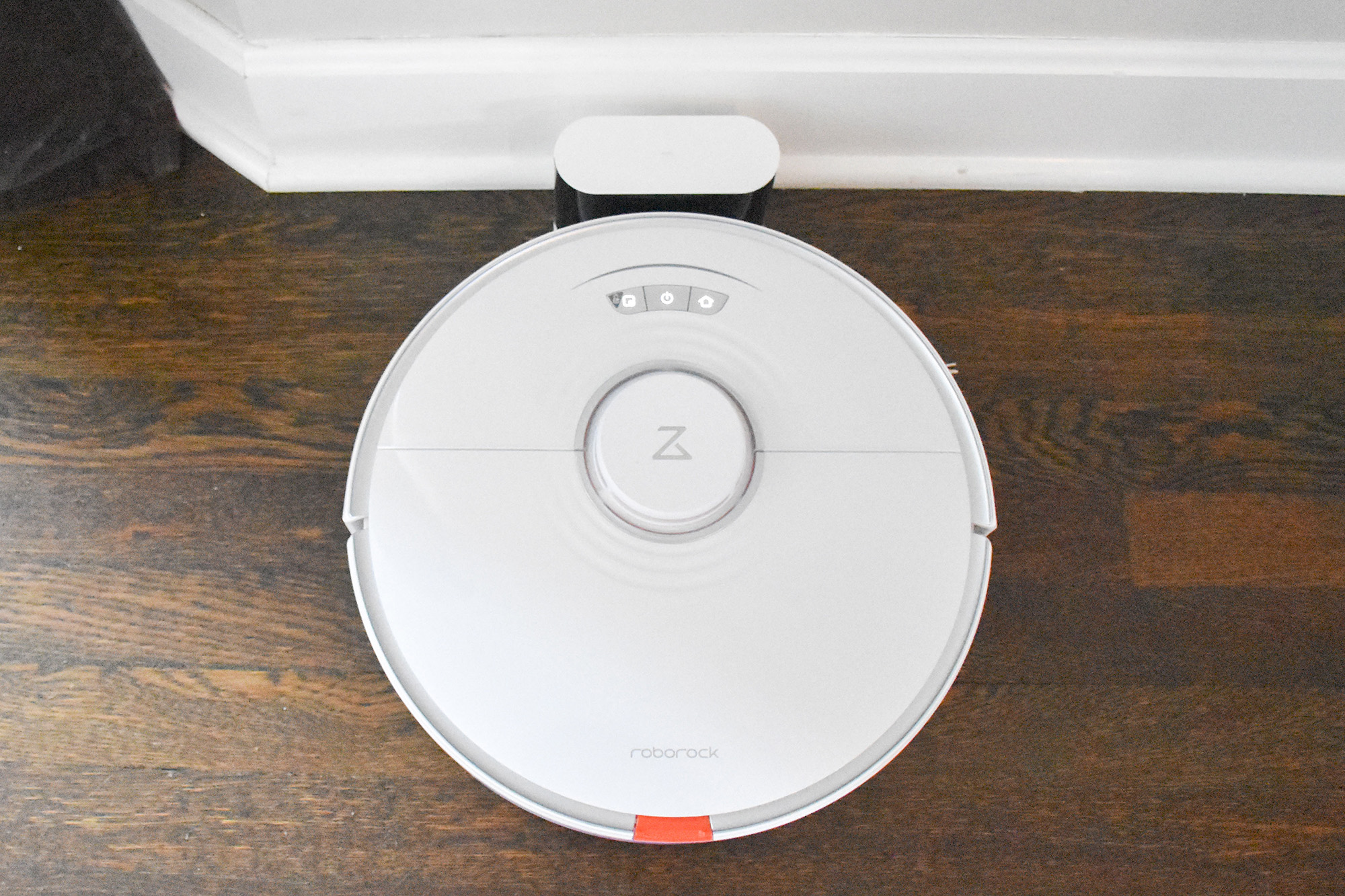
While its look isn’t revolutionary, the Roborock S7 has a few design touches that give the bot a premium look and suggest power under the hood. First, there are concentric “ripples” that spread outward from the logo disc — a subtle nod to the sonic vibrating mop on the machine. Much like the iRobot Roomba s9, there’s a curved light that moves and changes color when the robot is in action. Though much smaller than the light on the Roomba s9, a white light zooms from left to right in normal vacuum mode. In spot cleaning mode, it changes from green to blue and back again.
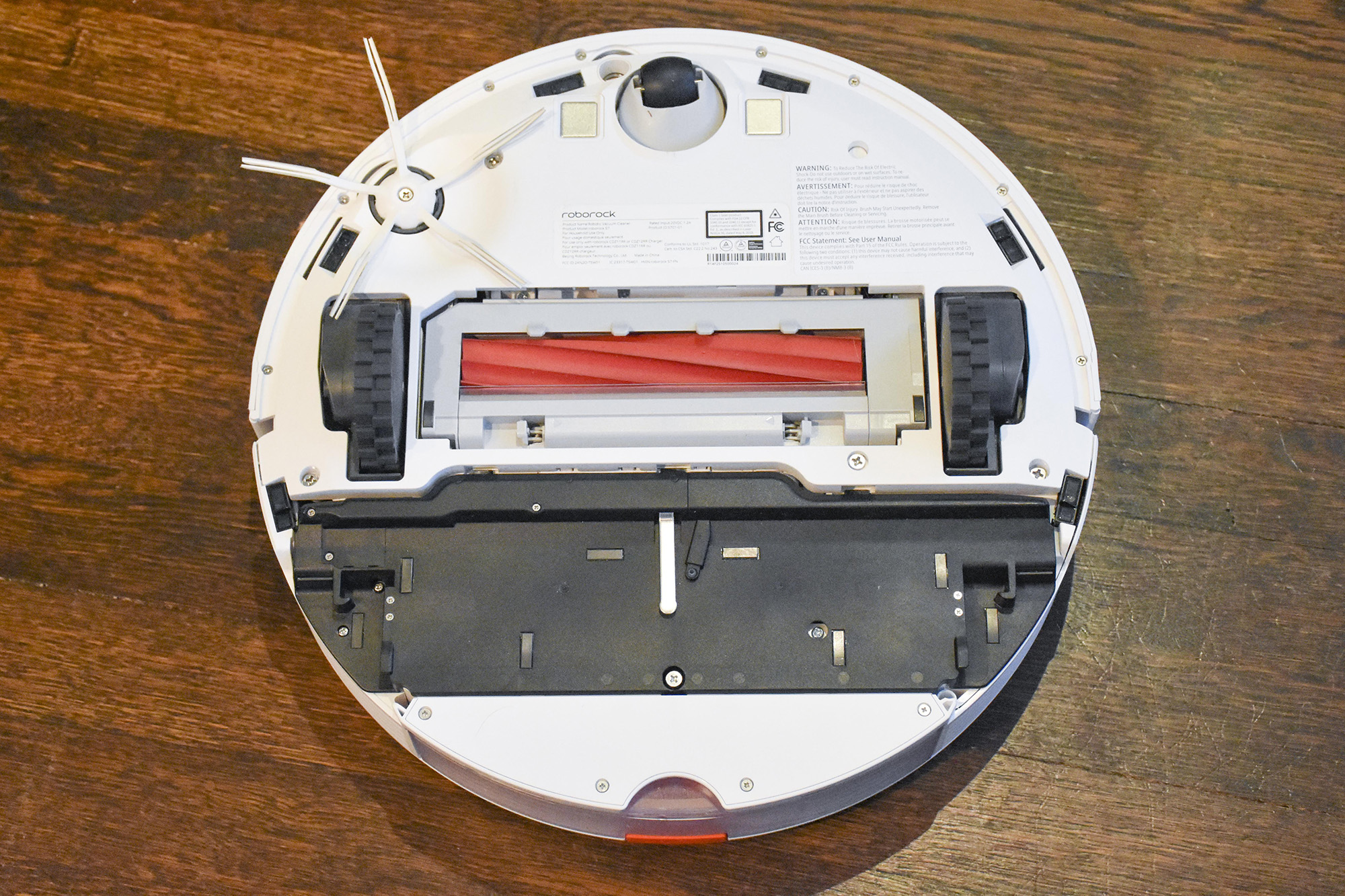
Those premium touches continue on the underside of the Roborock S7 where a red, studded, rubber-finned brush roll sits between two large black rubberized wheels. The company calls it a floating brush and says it’s able to get closer to the ground for better cleaning. The brush housing moves easily, but doesn’t feel fragile. A five spoke brush with rubber bristles sits to the left of the brush roll. A bevy of sensors are placed around the edges, including one that detects carpet near the omni-directional wheel in the front.
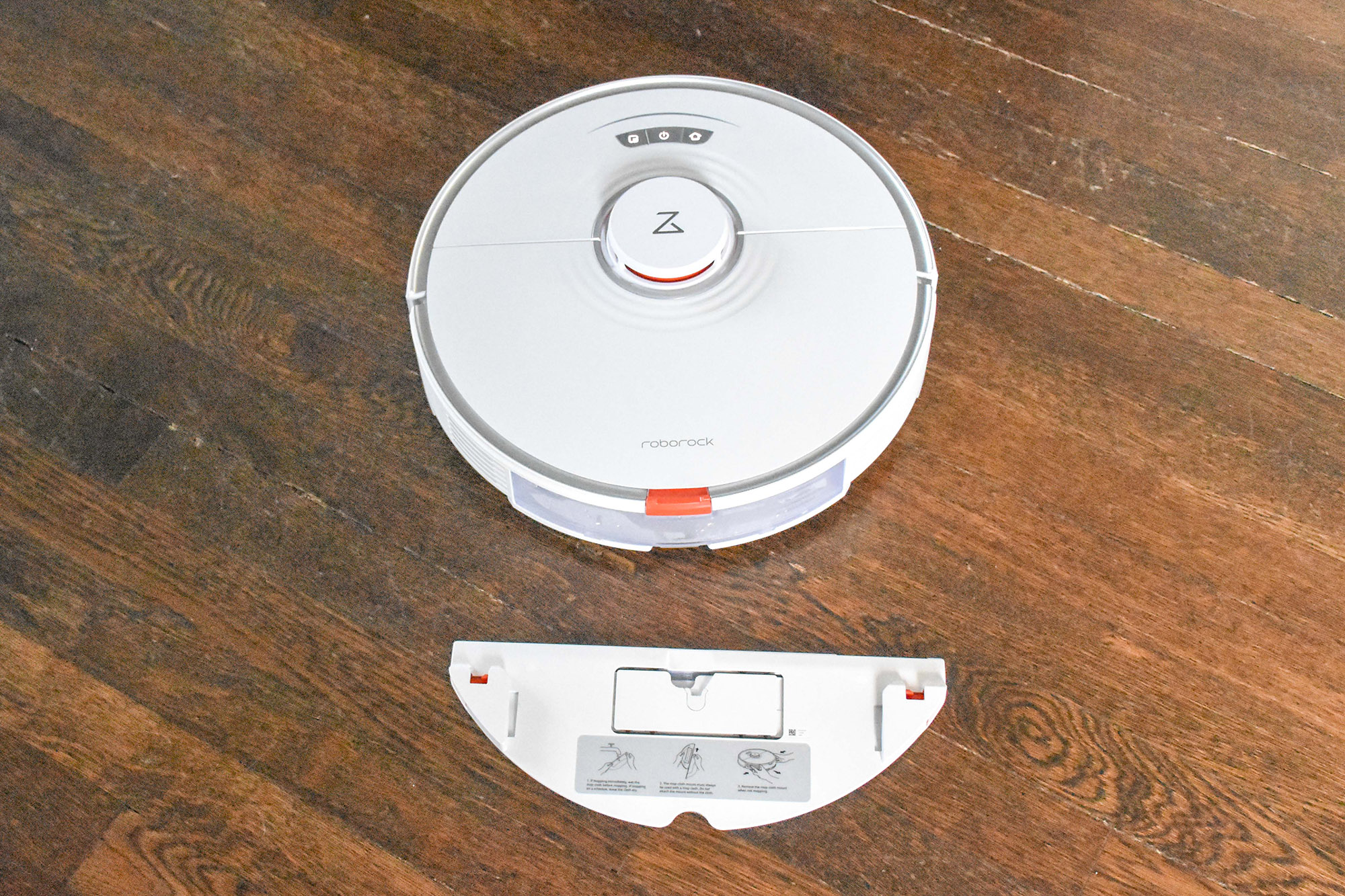
The Wi-Fi indicator light and dustbin are hidden under the thin plastic hood. The bin is easy to remove for emptying and can be cleaned under running water. It’s completely separate from the water tank, meaning you don’t have to manually switch out a dustbin for a water tank in order to change cleaning modes.

Unlike other hybrid models that just drag a microfiber pad around, Roborock has equipped the S7 with a sonic mopping system which offers multiple scrub settings via a removable half-moon-shaped mopping plate and reusable microfiber pad. But here’s the extra nifty feature: the mop part automatically raises up 5 millimeters (0.197 inches) when carpet is detected or when the bot is returning to the dock. The company calls it VibraRise technology, but what impressed me was that it actually worked consistently.
Roborock S7 review: Cleaning performance
Vacuuming with the Roborock S7 was a fairly quick exercise. It’s a relatively fast and thorough cleaner that offers strong overall performance. Because it uses Lidar for mapping, the vacuum was able to completely map my first floor in one run. Once a map is established, the S7 cleans methodically, outlining the edges of a room, then working in an S-shaped pattern. It’s gentle, too. Like most mapping robots, it slows down as it approaches a perceived obstacle. I watched it carefully approach a stepstool, clean underneath it, then back away. It bumped into the stool legs a couple of times, but never enough to move it.
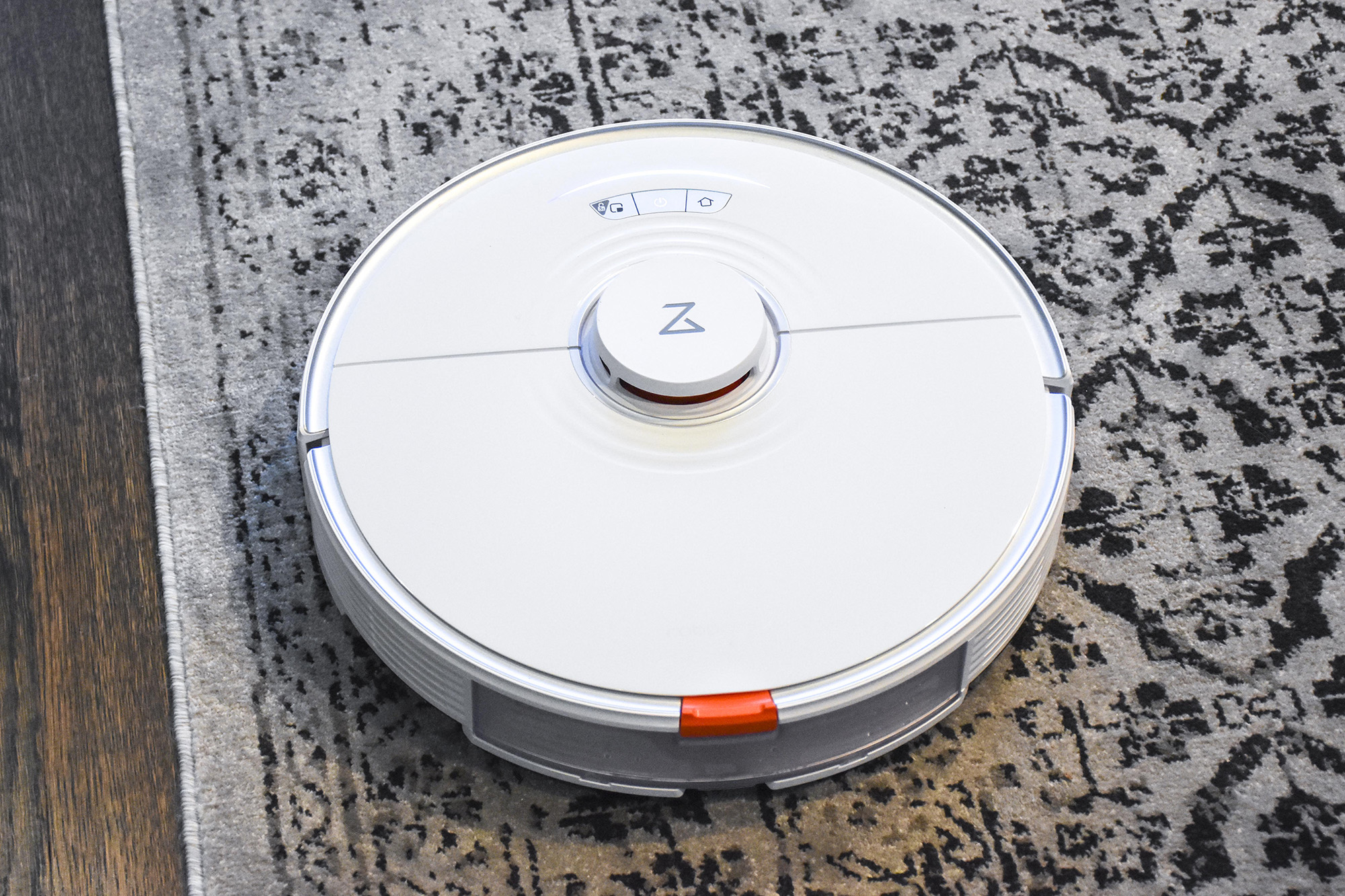
In our lab tests, the S7 earned an overall score of 92.97 — not quite as good as its vacuum-only sibling, the S4 Max, but slightly better than the iRobot Roomba i7 and Roborock S6 MaxV.
This vacuum performed best on hardwood, earning an average pick up rate of 95.4%, but it held its own on our carpet tests with an average pick up rate of 90.54%.
| Row 0 - Cell 0 | Overall Score | Cereal | Kitty litter | Dog hair |
| Roborock S7 | 92.97 | 98.4 | 94.7 | 85.82 |
| Roborock S4 Max | 96.25 | 98.38 | 96.38 | 94 |
| Deebot Ozmo T8 | 79.85 | 89.63 | 92.15 | 57.75 |
| Roborock S6 MaxV | 90.56 | 98.9 | 92.28 | 80.5 |
| Roomba i7+* | 90.4 | 93.1 | 87.6 | 90.5 |
| Shark Ion R85* | 94 | 100 | 94 | 88 |
*Same test performed in a larger 15’ x 15’ area.
On hardwood, the Roborock S7 picked up 96.8% of the Cheerios strewn about the test area. That’s nearly identical to the S4 Max’s score on the same task and just one point below the S6 MaxV. However, the S7 rolled over and crushed several Cheerios during our hardwood floor testing, making more of a mess that it then had to clean up.
Speaking of messes, though the Roborock S7 picked up 96% of the dog hair on hardwood, much of it was wrapped around the rubber brush roll and the front wheel. Thankfully, both the brush and the wheel were easy to remove and clean.
| Row 0 - Cell 0 | Cereal | Kitty litter | Dog hair |
| Roborock S7 | 96.8 | 93.4 | 96 |
| Roborock S4 Max | 96.75 | 97.75 | 100 |
| Deebot Ozmo T8 | 86.35 | 92.3 | 57.5 |
| Roborock S6 MaxV | 97.8 | 96.3 | 78 |
| Roomba i7+* | 93.4 | 87.9 | 88 |
| Shark Ion R85* | 100 | 95 | 77.5 |
*Same test performed in a larger 15’ x 15’ area.
A big highlight of the Roborock S7 is its ability to automatically detect carpet and increase suction accordingly. That increased suction bore out in the scores on two of our three carpet tests. The S7 earned a perfect score cleaning up Cheerios from our test carpet, even though it resembled a 4x4 on rough terrain as it rolled over cereal pieces before picking them up.
Likewise, the S7 was equally impressive in the kitty litter test, picking up 96% of the granules, one point better than the Roborock S4 Max. When it came to dog hair, the S7 stumbled, cleaning up 75.6% of the hair. The vacuum tended to roll over the hair, pushing Fido’s fur further into the carpet, thus making it harder for the vacuum to pick up.
| Row 0 - Cell 0 | Cereal | Kitty litter | Dog hair |
| Roborock S7 | 100 | 96 | 75.6 |
| Roborock S4 Max | 100 | 95 | 88 |
| Deebot Ozmo T8 | 92.9 | 92 | 58 |
| Roborock S6 MaxV | 100 | 88.25 | 83 |
| Roomba i7+* | 92.7 | 87.3 | 93 |
| Shark Ion R85* | 100 | 93 | 98.5 |
*Same test performed in a larger 15’ x 15’ area.
Roborock S7: Mopping performance
Throughout my testing of dozens of robot vacuums and robot mops, I’ve typically found hybrid vacuum and mop robots to be jacks of all trades but masters of none. The Roborock S7 is a pleasant surprise. First, it’s smart enough to avoid mopping most carpets. While the 5 millimeters the mopping plate raises itself doesn’t sound like much, I found it was enough to avoid getting my carpet wet. A slightly thicker door mat felt minimally damp after the S7 traveled across it, but less wet than if I’d stepped on it after walking in the door during a rainstorm. However, the mopping attachment tended to catch the edges of area rugs, causing the corner to temporarily roll up underneath the vacuum before the bot freed itself.
Like the Roborock S6 MaxV, the S7 is able to both vacuum and mop at the same time. Unlike the S6 MaxV, it did both tasks well. The Roborock S7 vacuumed up a pile of breadcrumbs on my kitchen floor and mopped it clean. It was in this instance where I saw the best use of simultaneous vacuuming and mopping: The damp mop pad was able to catch the miniscule crumbs that the vacuum didn’t.
The VibraRise auto-lifting mop pad combined with the carpet detection makes the difference with the Roborock S7. In my Roborock S6 MaxV review, I lamented that the bot could detect carpet, but couldn’t use that information to keep the mop off the carpet. While lifting the mop pad 5 millimeters isn’t going to save every area rug from getting mopped, it does help.
In the Roborock app, you can choose between Standard mopping, which vacuums and mops simultaneously, or Deep Mopping. With Deep Mopping, the S7 will move in a tighter pattern and cover the specified area twice. I didn’t notice a big difference in cleaning between the two modes other than the vacuum not running. In both modes, you’re able to choose your preferred “Scrub Intensity:” Close, Mild, Moderate, or Intense. I was able to see and hear the difference in the mop vibration as switched between scrubbing options. According to Roborock, the sonic vibrations range from 1,650 to 3,000 times a minute. By comparison, the vibrating mopping attachment sold by Ecovacs to attach to the Deebot Ozmo T8 oscillates at 480 times a minute and doesn’t raise its pad.
Roborock recommends running the microfiber pad, detached from the mop plate, under water before using. I found this solved a problem I’ve had with other hybrid mops like the iLife V5s Pro — namely, not getting the floor wet enough to look like it’s even been touched by a mop. On the S7, water drips onto the pad while it’s mopping via the electronically-controlled water tank. Like almost all robotic mops, water —and only water — is allowed in the S7. While water alone isn’t going to make your floors look brand new, it’s good enough for getting light spots off the floor and in between more thorough mop and bucket cleaning sessions.
Roborock S7: Setup, app, and mapping
Getting the Roborock S7 up and running took less than five minutes once it was situated on its dock and charged. Like other recent Roborock robot vacuums, it’s controlled via the Roborock app (Android and iOS). While I loathe the idea of creating yet another account with credentials to keep track of, that’s what you have to do here. Once the account is set, adding a new robot and connecting it to my home wifi network was quick as the app walked me through the process.

The Roborock S7 supports four separate maps. I used one map for the first level of my home and one for each test area. The S7 is smart, but you’ll need to tell it which map to use if you move it to a different location. To do this, you’ll have to go into Settings > Manage Maps or access it from the Edit Map button on the main device page. Then tap Restore to make the map you want to use active. From here, you can also instruct the bot to create a new map. It feels a little tedious, but it offers more control than the iRobot Home app, which doesn’t let you choose to make a new map — it just decides to do it.
Once a map is created, the Roborock app will attempt to divide it into rooms. Don’t expect a miracle, especially if your home has an open floor plan. Thankfully, Edit Map > Edit Room allows you to merge, divide, and name rooms. Room division is far from perfect and I was dismayed to run into the same dividing issue that I did with the Roborock S4 Max: the “Reset failed” error, which is triggered by rooms having more than one entry point. My solution was to draw one line through the center of the map and then divide and merge rooms as needed.

Particular about exactly how much vacuuming and mopping you want in each room? The Roborock app allows you to customize the vacuum power and scrub intensity in each individual room or throughout the whole level. Only need cleaning around the kitchen sink and table? Set up one or more zones to be cleaned and specify how many times (up to three) you’d like the Roborock S7 to clean that zone.
Perhaps more important than go-to zones are no-go and no-mop zones. While the Roborock S7 detects carpet and shows it on the map, drawing a no-mop zone around it isn’t perfect. I used the carpet demarcation on the map as a guide for a no-mop zone in my dining room. While the S7 mostly stayed away, it interpreted the no-mop zone as starting about 6 inches in from the edge of the rug. However, thanks to the auto-rise mop plate, my rug stayed dry. The no-go zone worked similarly; I boxed out my dog’s food and water bowls, but made the zone a little too large, causing the S7 to miss the floor next to the bowls. It’s definitely a trial and error process.

Thankfully, the app shows you exactly where the Roborock S7 has cleaned, including the path it took from the dock. You can track the vacuum’s progress right in the app and, should it get stuck, you’ll know where to find it. It’s a nice feature and gives you a clearer picture of any spaces the robot might have missed due to obstacles or other minor calamities.
Roborock S7 Auto-Empty Dock
We found the self-emptying base for the Roborock S7 straightforward to assemble. You attach the two major parts into an L-shape using the supplied screwdriver which comes as part of the base. It’s nice that you can fit the screwdriver back into place should you ever need it again as well. Before operating the robot vacuum, you need to remember to remove the plate covering the air inlet in the dustbin for it to be able to auto-empty. This is a small, but essential modification to use the base.
The dust bag in the base is easy to fit in place and you simply pull it up to remove. It holds up to 120 days of dust before needing replacing and seals itself shut on removal to prevent dust from going everywhere. These are widely available to buy on Amazon starting from $20.99.
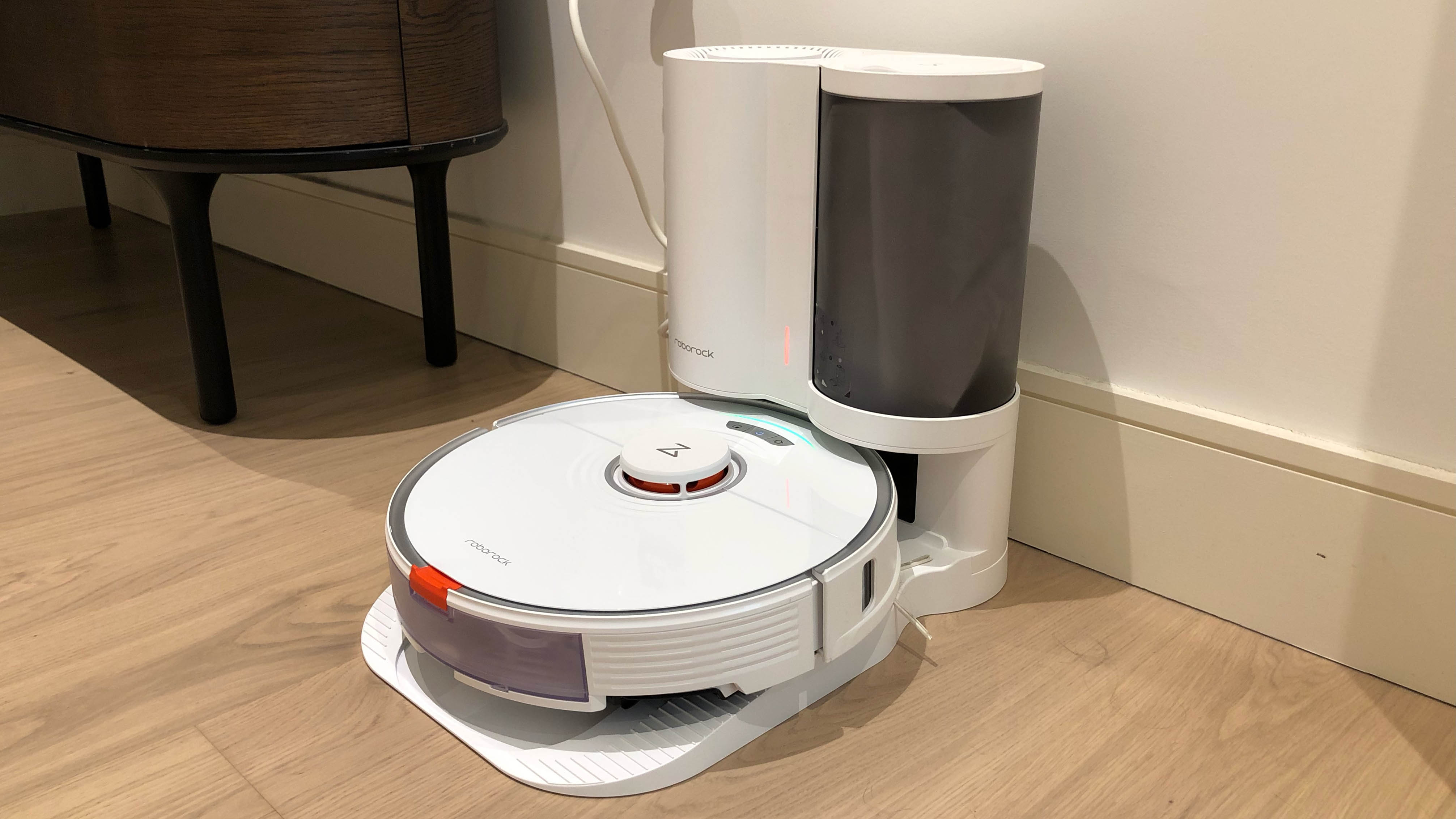
The filter is also easy to remove from the base, although I couldn’t take it apart easily for cleaning — which appears to be possible in the manual. You can also remove the dust bag canister to clean the dust inlet should that get blocked. The canister isn’t easy to grip from the outside as you attempt to remove it, but if you pop open the lid you can grip it from the inside which is much better.
When we used the S7 with the auto-empty dock, we found the robot returned to its base successfully each time and didn’t nudge it out of place as it parked. You can auto-empty straight from the app, or the robot vacuum can do so automatically with each run (you can switch this off in DND mode). There are four self-empty settings available (Smart, light, balanced and max), which adjust the power accordingly.

We tried the Light setting at first, which was quite loud — just a bit louder than you would expect from an upright vacuum. It took less than a minute to finish running. However, we were disappointed to see that the dust and debris was mostly caught under the robot vacuum the first time we ran it. We tried it again in Max mode, which lasted just under 30 seconds and didn’t sound much louder than the Light mode. It worked this time — no dust to be found under the robot vacuum.
The self-emptying base is definitely useful to have, particularly if you’ve got allergies and don’t like the maintenance of emptying your robot vacuum’s dustbin. If you’ve already got the Roborock S7, it’s also nice that you can buy the base separately and upgrade for $299 (Amazon). Be prepared that the two together are fairly bulky in size and will make an impression, but it’s not overly obtrusive and looks quite smart.
Roborock S7 review: Verdict
The Roborock S7 is the first hybrid vacuum and mopping robot that I’d actually let mop my home unsupervised. The auto-rising mop plate and carpet detection work consistently well. While the mop isn’t going to clean your floors well enough to eat off of them, it does a good enough job to fool houseguests. Plus, it’s a solid, fast cleaning vacuum with loads of in-app customizations. The auto-empty dock is a useful addition if you struggle with allergies and want to simplify its maintenance as well.

If you don’t need the mopping, take a look at the $429 Roborock S4 Max, which is our current favorite robot vacuum. But if you want your robot vacuum to multitask, the Roborock S7 offers strong overall vacuuming performance with predictable water-only mopping that won’t soak your rugs.
Meghan McDonough is a journalist who currently tests and writes about robot vacuums. Since 2008, she’s written about laptops, mobile phones, headphones, speakers, and other consumer tech. When she sees an unfamiliar device, Meghan has a habit of asking complete strangers, “What is that? Does it work well for you?”
In her spare time, Meghan enjoys seeing live music, tending to her garden, and playing endless games of fetch with her Goldendoodle, Duke of Squirrel.
